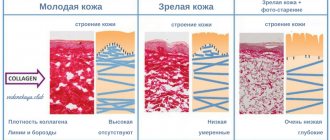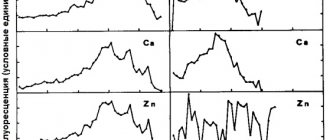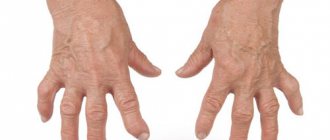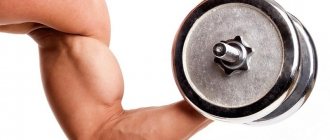There are many useful recipes in folk medicine. Healing herbs, decoctions of dried berries, red pepper, ginger - what the natural pantry offers for the treatment of a wide variety of diseases. There are also recipes that recommend healing joint diseases by regularly taking regular gelatin. And although this is one of the subtypes of collagen protein, which is really needed by the body and is beneficial for the joint-ligamentous apparatus and muscle tissue, its consumption can be harmful to health. To understand which product is healthy and which is not, you need to know and distinguish between the types of proteins and types of collagen.
Cosmetic collagen applied to the skin in creams and gels should be separated from food collagen taken orally. In the first case, collagen allows you to retain moisture in the epidermis and activates the action of the other components that make up these cosmetics. Only internal intake of collagen is beneficial for health. The degree of processing is also fundamentally important, on which the bioavailability of the product depends - the amount of active substance absorbed by the body without loss.
Types of collagen and proteins. What is the difference between them
Collagens belong to a group of fibrillar proteins that have an elongated filamentous structure and are known to consist of two dozen types of different amino acids.
There are two main types of protein—from living organisms, and from plants and fungi. Let’s immediately make a reservation that only animal protein collagen has an amino acid composition that is closest to proteins in the human body. The composition of plant proteins has a limited set of amino acids, although useful, but insufficient for balanced nutrition of the body. In turn, collagen from living organisms is divided into animal (made from animal raw materials) and marine (from creatures living in water).
Animal collagen is extracted from cattle hides, bones, and cartilage. It is most often a raw material for further processing, the final product of which is collagen hydrolyzate, consisting of low molecular weight peptides (short chains of amino acids) that are well absorbed by the body. Its amino acid composition most closely matches the composition of collagen in the human body.
The raw materials for protein production are often milk (whey) or eggs. Proteins from milk or eggs are a very valuable food product, but the set of amino acids in them still does not fully meet the body’s needs for the synthesis of its own collagen.
Marine collagen is made from small trash fish, the skins of large fish or seafood. This is a more expensive product than those made from animal skins and requires special storage conditions. Marine collagen is often used to produce cosmetics.
Plant protein is produced from grains or legumes, but it is protein, not collagen.
Collagen is found only in multicellular organisms, and “plant collagen” simply does not exist in nature! That is, the types of collagen (not protein, but collagen) needed by the body are only animal and marine.
Let's figure out how to choose the right collagen. Comparative analysis
There are a number of irreplaceable components that need to be replenished. Otherwise, the body fails. One of the important elements is collagen.
The relevance of the topic is difficult to dispute, so we decided to collect and analyze the most interesting materials for you. We will highlight useful information and help you understand the issue of taking dietary supplements containing Collagen. So let's start in order.
What is collagen and what are its benefits?
Collagen is a structural protein that makes up all the connective tissue in our body. From the name “connective” it is clear that its main function is to connect all tissues and organs. Therefore, long and strong collagen molecules provide its main purpose by being present in almost all parts of the human body.
In tissues, collagen is not present in its pure form, but in the form of an intercellular matrix. In addition to collagen fibers, which provide elasticity and strength to the matrix, it contains elastin, fibrin and hyaluronic acid. And what is important is that each of them plays an irreplaceable role. All cosmetologists and pharmaceutical companies are struggling to preserve this matrix.
As we age, it becomes more difficult for the body to produce the required amount of collagen. This is why the first wrinkles appear on the face, then a crunch appears in the joints, and then internal organs begin to malfunction.
Without collagen, the body “dries out” and becomes older. Therefore, doctors and nutritionists recommend including it in your diet after 35 years for everyone without exception.
Even small preventive courses can bring considerable benefits to an aging body.
Many types of collagen. Which to choose
Like any protein, collagen is made up of amino acids. Basically, these are three amino acids that predominate in the chain - Glycine, Hydroxyproline and Arginine. Depending on the sequence of amino acids and molecular structure, there are about 28 types of collagen in nature.
The main and important for maintaining health and beauty are types 1, 2 and 3.
So, let's take a closer look at each of them:
- Type 1 is found in all types of tissues of the human body. This component is responsible for elasticity, water balance and nutrient absorption. This is collagen for skin, bones and connective tissues.
- Type 2 – collagen for joints and tendons. The element acts as a medicinal and preventive remedy for rheumatism, arthritis and other diseases and inflammation. Used in both dietary supplements and ointments. This type requires a careful approach and a special dosage during treatment.
- Type 3 is also called the “young” component. Responsible for elasticity, metabolism and the condition of skin cells in general (including hair, nails).
Types 1 and 3 are responsible for rejuvenation of the body, tone and general condition, while type 2 ensures the restoration of joints, discs, and cartilage.
Origin plays a role. Animal or sea
We must admit that we cannot obtain collagen in sufficient quantities from food, so today dozens of technologies have been developed for producing collagen on an industrial scale from various sources of animal origin.
- Animal. Produced by processing the hides and joints of cattle
- Nautical. Obtained by scraping the top skin cells of marine fish
Animal collagen is the most common and accessible type. Production involves the processing of cartilage, joint tissue, mammal and bird skins. It is the most studied and tested over years of use in cosmetology and nutrition. This type is the simplest and most accessible among its analogues.
- Well absorbed when taken orally
- Due to the large molecule, it penetrates poorly through the dermis
- Affordable price
- Easy to store
Marine collagen is a product obtained from the epidermal tissues of fish and other sea creatures.
This protein is considered more effective, since it is completely absorbed through the intestinal walls when it enters the body. Production technology also requires special equipment and high-quality transportation.
This product breaks down more easily and requires careful storage, which is why its cost may be higher.
- Well absorbed when taken orally
- The molecule is closest to human. Passes better through the dermis
- Promotes the production of “native” collagen
- Difficulties of production. Higher price
- Requires sterility during storage
Some experts also distinguish a plant species. Wheat, like other cereals, does not have protein itself, so the gluten, which is contained in the germ of the seeds, undergoes hydrolysis (or decomposition to the molecular level under the influence of water). The resulting elements are fermented and used in the production of cosmetic or therapeutic products.
- The structure is similar to that of an animal, but cannot be called collagen
- Hypoallergenic
- Well absorbed on the surface of human skin
- Complex production
- Very high price
Marine collagen and animal collagen are currently optimal and most promising in terms of digestibility and safety for taking as a dietary supplement. For the best effect, they must be alternated. First there is a course of animal collagen - then a course of marine collagen.
You need to understand that the most effective collagen for the body is collagen synthesized by the body. It is this and only this that the body uses for the intercellular matrix, connective tissue and cartilage. Therefore, the best way to replenish your body with collagen is to provide it with “building materials,” namely, peptides and amino acids.
https://www.youtube.com/watch?v=AI6lOACCBNc
Essentially, drinking collagen, which we take orally, is better the more it is hydrolyzed. This means that the more long collagen fiber is broken into smaller pieces, the easier it is for our body to absorb. Therefore, it is ideal to consume collagen hydrolyzed to a mixture of peptides and amino acids. The body will only have to absorb it and synthesize our “native” collagen.
Today, all manufacturers produce already hydrolyzed collagen, and if we talk about dosage forms, then the same hydrolyzed powder will be in capsules, powder and liquid form.
- Powder . Used for preparing mixtures and cocktails. After administration, it begins to penetrate the walls of the gastrointestinal tract and act within 30 minutes. The package contains a special spoon with which you need to measure the dose. the most rapidly absorbed form of collagen. The most economical form. The most accessible form.
- Capsules . The structure is a powder in a self-soluble gelatin shell. This form is easy to use and convenient to transport. The capsule has no taste or smell. Costs a little more than powder.
- Liquid form . Enriched form of collagen. In this form, you can find not only proteins and amino acids, but also additional vitamins and minerals. The concentrated substance in liquid form is quickly absorbed, but may cause problems with storage and transfer. The most expensive form of collagen.
- Pills . Convenient form that requires a larger dosage. Due to the excipients, the tablet contains a small dose of the active ingredient, so a serving consists of 6 tablets, which should be taken during the day.
- Candies . Chewing candies, marmalade and other forms of your favorite sweets have a pleasant aroma and taste. A special series with collagen is designed for taking 1 candy per day.
Among the various options, everyone chooses what is acceptable for personal use. The main differences between the forms are ease of use, digestion time, and cost.
Daily norms of collagen
It is important to understand that when we talk about the daily norm of collagen, we mean that this does not apply to the collagen itself, but to the mixture of peptides and amino acids that make up hydrolyzed collagen.
Daily rate:
- Preventive norm – 5 grams per day
- Therapeutic norm – 10 grams per day
In most cases, manufacturers place a measuring spoon just for the preventative volume of 5 grams.
How and with what is better to take collagen
1 Rule
We accept collagen types 1 and 3 and collagen type 2 - in separate courses! Taking these types of collagen at the same time will not give the desired effect. The body will receive the wrong ratio of amino acids.
2 Rule
The classic course of collagen is 3 months on, 3 months off. This mode provides the necessary prevention. The body receives the missing amount of certain amino acids for the synthesis of its “native”. During a therapeutic course (problems with joints, menopause), the course is increased to 6 months and a 2-month break.
3 Rule
It is recommended to take collagen 30 minutes before meals. This way the body receives the correct ratio of amino acids.
- A measuring spoon of collagen is diluted into 15 ml of any non-hot drink. The drink must not contain protein
- Stir until lumps disappear. Add 200-250 ml. You can mix with a shaker.
- Drinks for mixing can be selected according to your taste. Most often it is water or juices.
Additional composition
When looking at the composition, pay attention to additional components that can enhance the effect of the main element, increase its bioavailability or ensure its synthesis. As for collagen, it is necessary to highlight several main substances that can be found in the composition.
- Vitamin C. Without it, collagen synthesis in the body is impossible! Only in the presence of vitamin C can amino acids bind and properly form collagen fibers.
Vitamin C deficiency stops collagen synthesis. We all know that scurvy is the main disease caused by a lack of vitamin C, which manifests itself as ulcers on the gums, but did you guess that these ulcers are precisely a consequence of the fact that the body cannot synthesize collagen, and therefore connective tissue throughout the body. It's just more noticeable on the gums.
- Hyaluronic acid. Like collagen, it is an important part of the intercellular matrix. Therefore, it plays an important complementary role in recovery, retaining water molecules in the matrix.
Analyze and compare
Finally, let’s compare several worthy collagen options available on our market.
Which collagen is better, marine or animal?
Collagen amino acids are the building blocks, the best building materials, that the body uses to create its own collagen molecules. Moreover, animal collagen contains several essential amino acids, which are not produced by the body itself and can only be supplied to it with animal food containing them. These amino acids are also found in marine collagen, but when answering the question of which collagen is better, marine or animal, we can say that animal is preferable. Firstly, because sea water can cause severe allergies, and secondly, because of its higher cost. Hydrolyzate from marine collagen is similar in properties to hydrolyzate obtained from animal skins, bones and cartilage.
Collagen for joints in the form of collagen hydrolyzate - what are its benefits?
Collagen for joints is simply necessary. A sufficient amount of it is the key to healthy connective tissue, joints, and tendons. As we age, the amount of natural collagen produced by the body decreases. And anyone who monitors their health, exercises intensely and does not want to get joint and spine disease needs hydrolyzed collagen for joints. It is a product of deep processing of animal raw materials, absorbed by the body quickly and in the required quantities. It is collagen hydrolyzate that is part of the Collagen Ultra supplement. When choosing “what to drink for joints” , you can choose this one. This easily digestible drug is recommended to be taken in a course for three months.
Experts' opinion
Collagen-containing cosmetics with any type of substance are classified as anti-aging products . Its continuous use, especially in people under 40 years of age, can stop the production of its own protein fibers in the epidermis. This is fraught with rapid aging of the skin. Under the age of 35, it is better to make masks with gelatin. The food product is an analogue of Collagen, but does not disrupt the synthesis of the substance. However, you can use homemade cosmetics containing it for a short course to improve your skin, hair, and nails.
Neither gelatin nor collagen are able to restore the level of this protein, as in young and healthy tissues. Doctors warn that treating joint and other diseases only with these products is ineffective: the pathology will progress. Both drugs are useful in monotherapy for the prevention of arthrosis, osteochondrosis, collagenopathy, or for the purpose of inhibiting the aging process. But if the disease develops, diet therapy, liniments, supplements and gelatin are used in combination with medications.
What to drink for joints? Treatment of joints with gelatin
You can find recommendations that use gelatin to treat joints as a source of collagen. However, the benefits of gelatin for joints are absolutely ambiguous. On the one hand, edible gelatin is a product of the first stage of processing animal raw materials with a relatively high degree of purification. But the collagen molecules in gelatin are very large in size and have a chemically strong structure and are poorly digested, as a result of which gelatin has very low bioavailability. Under the influence of a variety of factors (disease, harmful environment, old age, physical activity), gelatin is not fully absorbed in the body or is not absorbed at all. Its molecules, due to the lack of digestive enzymes in the body, are not broken down in the stomach and leave it undigested. Subsequently entering the duodenum under the influence of its intestinal juices, these undigested molecules still dissolve, but are no longer absorbed in the small intestine, forming harmful toxins in the gastrointestinal tract. Therefore, under no circumstances should you take gelatin, and even in large quantities, as is sometimes recommended in folk recipes for the treatment of joints.
Recommendations for using the product
Gelatin is available in several forms: powder, plastic or granules. The high quality of the product is evidenced by its transparent color and lack of odor.
Store the drug for no more than 1 year in a cool, dry place.
To use gelatin for cosmetic purposes, the following tips will be useful:
- apply only to cleansed skin;
- exclude facial expressions during gelatin procedures;
- requires pre-soaking for 25 minutes with cold water, then placing in a water bath for 5-10 minutes;
- the area around the eyes should be approached with caution to avoid the opposite effect;
- It is not recommended to use more than 2 times every 7 days.
In bodybuilding and powerlifting, to strengthen bones, ligaments and joints, collagen in tablets or gelatin is recommended to be taken in a dose of 10 g per day, in 1 or 2 doses in dry form, washed down with water, dissolved in water or made into jelly.[11] The supplement is absolutely safe and is of completely natural origin (made from animal bones and cartilage through prolonged cooking and subsequent destruction by enzymes or acids).
To increase the effectiveness of the course, it is recommended to combine it with chondroitin sulfate and glucosamine sulfate. Or use in conjunction with other supplements for ligaments and joints. And plenty of vitamin C.
Not everyone digests edible gelatin equally well. Excess gelatin can cause many problems, among which the most harmless is an increase in blood clotting.
People who are predisposed to thrombosis and thrombophlebitis, as well as those who suffer from urolithiasis and cholelithiasis, should not abuse products containing gelatin, as they can provoke an exacerbation of the disease.
It is also important to remember that gelatin tinctures, which are used to treat joint diseases, can lead to constipation, inflammation of hemorrhoids, and problems with the gastrointestinal tract.
Also, people suffering from cardiovascular diseases and oxaluric diathesis should consume gelatin only after consulting a doctor, since the increased oxalogen content in this product can cause an exacerbation of these diseases.
In addition, there are known cases of allergies after eating products with gelatin.
Which is better, gelatin or collagen in the form of hydrolyzate? What are the benefits of collagen hydrolyzate?
The benefits of gelatin for joints are very doubtful. This is an ineffective, poorly digestible animal product that causes many side effects. Its only advantage over deeply processed collagen is its low cost.
Collagen hydrolyzate, which is part of Collagen Ultra, really helps by maintaining healthy joints. It promotes the process of treating complex chronic diseases such as arthritis, arthrosis and others. When experts are asked what is better, gelatin or collagen in the form of hydrolyzate, they answer unequivocally - hydrolyzed collagen. It is a friend and helper for joints. After administration, it is absorbed into the blood as quickly as possible, without causing allergies, and begins to act just two to three hours after administration.
Collagen hydrolyzate, which is part of Collagen Ultra, contributes to the treatment of complex chronic diseases such as arthritis, arthrosis and others.
When deciding what to drink for joints, the consumer should remember that all types of collagen have a cumulative effect, so you need to take Collagen Ultra in a course that lasts 3 months. This is exactly how long it takes to saturate the joint and connective tissue with nutritional amino acids. The first positive results are noticeable after a month of regular use.
WHERE TO BUY COLLAGEN ULTRA >>
Indications and contraindications for use
There are no fundamental nuances for applying gelatin masks to the face, but the main points are worth highlighting:
- Free the skin from cosmetics and wash using special foams or gels. It would be good to pre-steam your face and scrub it to free the pores of dirt.
- Take a soft brush, which will make it easier to apply the mask mixture.
- Distribute the mask strictly along the massage lines: from the center of the chin to the earlobes, from the edges of the lips to the middle of the ears, and so on upward. The nose is lubricated from the tip, moving further along the bridge of the nose and forehead towards the temples. The composition is applied to the neck from bottom to top.
- During the procedure, they take a lying position, try to relax all the muscles as much as possible and think only about pleasant moments. Since the gelatin mask tightens, it is advisable not to talk or show any emotions. Otherwise, the smoothing effect on wrinkles will not be as pronounced.
- Remove the gelatin mixture no earlier than twenty minutes.
The final touch will be applying a nourishing (moisturizing) cream to the skin. But before doing this, you don’t need to immediately wipe yourself dry with a towel. It’s better to lightly touch your face with it and remove the stains, and the remaining moisture should evaporate on its own.
To speed up drying, pat the pads of all fingers simultaneously along the contour of the face.
Gelatin molecules easily penetrate deep into the epithelium, actively affect cells, helping to achieve the following results:
- lightening of pigment spots and skin in general;
- increased tissue tone;
- effective cleansing of pores;
- softness, velvety skin;
- improved blood circulation;
- contour tightening effect.
There are no contraindications to the use of the product.
There is no need to stop gymnastic exercises to tighten the contours of the oval. They will enhance the success of the result.











